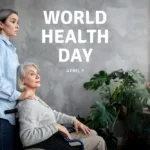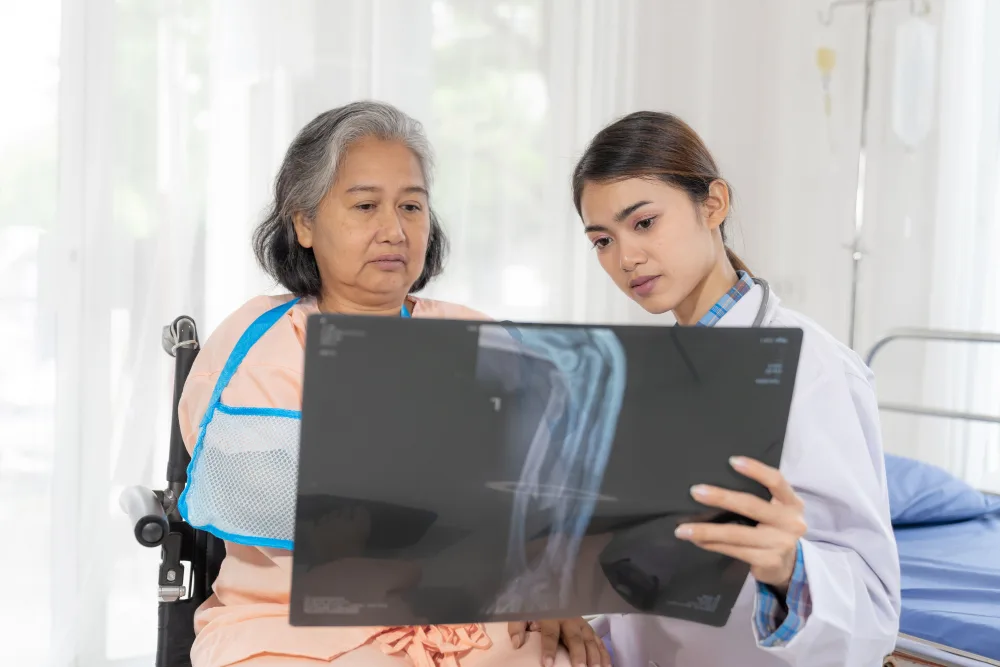
How to Handle an Elderly Emergency When You’re Far Away?
January 15, 2025
How Does World Health Day Inspire Healthy Ageing?
March 17, 2025Osteoporosis is a silent but serious condition that affects millions of older adults worldwide. It is a progressive bone disease that leads to reduced bone density and increased fragility, making bones more sensitive to fractures. Although it can affect individuals of all ages, it is particularly common among postmenopausal women and elderly men. Understanding how osteoporosis weakens bones and learning ways to prevent and manage it is important for maintaining bone health and overall well-being. In this article, we are discussing how Osteoporosis weakens in older adults and its prevention strategies.
What is Osteoporosis?
Osteoporosis, which means “porous bone,” is a condition characterized by the loss of bone mass and weakening of bone tissue. Bones are living tissues that continuously break down and rebuild through a process called bone remodeling. Osteoporosis develops when this balance is disrupted, causing bone loss to outpace bone formation. As a result, bones become brittle and more prone to fractures, particularly in the hips, spine and wrists. If you are looking for elderly care in Bangalore, Dr. Steves’s AGE Center can help support individuals with osteoporosis by providing medical assistance, mobility support and lifestyle guidance to maintain bone health.
Causes of Osteoporosis
Several factors contribute to the development of osteoporosis, including:
- Aging: As people age, bone mass naturally declines, making older adults more vulnerable to osteoporosis.
- Hormonal Changes: In women, a drop in estrogen levels after menopause accelerates bone loss. In men, low testosterone levels can also contribute to the condition.
- Nutritional Deficiencies: A diet lacking in calcium and vitamin D can weaken bones and impair bone formation.
- Sedentary Lifestyle: Physical inactivity leads to muscle and bone weakness, increasing the risk of osteoporosis.
- Medical Conditions: Conditions such as rheumatoid arthritis, thyroid disorders and chronic kidney disease can affect bone health.
- Medications: Long-term use of corticosteroids, certain cancer treatments and anticonvulsants can negatively impact bone density.
- Genetics: A family history of osteoporosis increases the likelihood of developing the disease.
- Lifestyle Factors: Smoking, excessive alcohol consumption and high caffeine intake can contribute to bone loss.
How Osteoporosis Weakens Bones?
1. Reduced Bone Density
Bone density is a key indicator of bone strength. In people with osteoporosis, bones lose minerals, primarily calcium, which leads to a decrease in bone mass. This makes bones weaker and more prone to fractures even from minor falls or everyday activities.
2. Structural Changes in Bone Tissue
Healthy bones have a dense, honeycomb-like structure with small spaces. In osteoporosis, these spaces become larger, reducing bone density and making bones fragile. The outer layer of bone, known as the cortical bone, also becomes thinner, increasing the risk of fractures.
3. Impaired Bone Remodeling
Bone remodeling is a continuous process in which old bone tissue is removed and new bone tissue is formed. In osteoporosis, the rate of bone resorption (breakdown) exceeds the rate of bone formation, leading to an overall decrease in bone mass.
4. Increased Risk of Fractures
As bones weaken, they become more susceptible to fractures, even from minor falls or sudden movements. Common fracture sites include the spine, hips and wrists. Spinal fractures can cause a stooped posture, loss of height and chronic pain, significantly affecting an individual’s quality of life.
Symptoms of Osteoporosis
Osteoporosis is often called the “silent disease” because it progresses without noticeable symptoms until a fracture occurs. However, some early warning signs may include:
- Receding gums (due to bone loss in the jaw)
- Weakened grip strength
- Brittle nails
- Gradual loss of height
- Back pain due to collapsed vertebrae
- Fractures from minor falls or injuries
Diagnosis and Screening
Early detection of osteoporosis is essential for effective management. Bone density tests, such as a Dual-energy X-ray Absorptiometry scan, are commonly used to measure bone mineral density. Blood tests may also be performed to assess calcium and vitamin D levels. Consulting a geriatric specialist near you can help with early diagnosis, personalized treatment plans and preventive measures to maintain bone health.
Preventing Osteoporosis
Osteoporosis cannot always be prevented, but certain lifestyle changes can help reduce the risk:
- Adequate Calcium and Vitamin D Intake: Calcium strengthens bones, while vitamin D aids calcium absorption. Dairy products, leafy greens and fortified foods are excellent sources.
- Regular Weight-Bearing Exercise: Activities like walking, jogging and resistance training help maintain bone density and strength.
- Avoiding Smoking and Excessive Alcohol: Both habits contribute to bone loss and should be minimized.
- Maintaining a Healthy Diet: A balanced diet rich in protein, magnesium and phosphorus supports bone health.
- Getting Regular Bone Density Tests: Early detection can help prevent severe bone loss.
Managing Osteoporosis
If diagnosed, several osteoporosis treatment options can help manage the condition:
- Medications: Bisphosphonates, hormone replacement therapy and other drugs can slow bone loss and improve bone strength.
- Lifestyle Modifications: Engaging in regular physical activity and ensuring a nutrient-rich diet can help preserve bone mass.
- Fall Prevention: Using assistive devices, improving home safety and practicing balance exercises can reduce the risk of fractures.
- Physical Therapy: Strengthening exercises and posture training can improve mobility and reduce the risk of falls.
Osteoporosis is a serious health concern for older adults, leading to weakened bones, increased fracture risk and reduced quality of life. Although the condition develops silently, understanding its causes, effects and prevention strategies can help individuals take proactive steps toward maintaining strong bones. Minding a healthy lifestyle, getting regular screenings and following medical advice helps older adults to reduce the impact of osteoporosis and continue to live active, independent lives.

